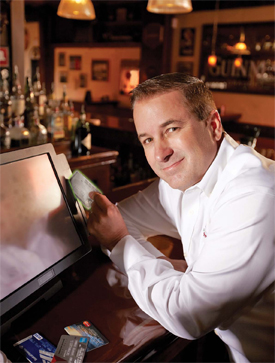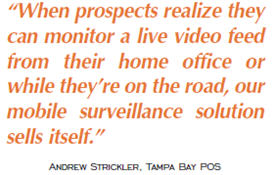A 3-Point Strategy For Steady POS Sales Growth
By Matt Pillar, Business Solutions Magazine
With a 20% growth rate, this hospitality and retail IT VAR has proven his three growth strategies work.

How could Andrew Strickler have possibly known how poor his timing was? When he founded Tampa Bay POS Systems in 2003, he tasted success almost immediately. He had a solid solution for the hospitality industry, built on a proven hardware/software combination that commanded a healthy 40% profit margin. The economy was good, new restaurants were opening all the time, and the livin’ was easy. How could he have known that even as he enjoyed that initial success, the POS resale industry was on the cusp of a rapid and dramatic shift that would commoditize POS systems and effectively cut his profit potential in half? And, how could he have prepared for the economic collapse that came on the heels of this sea change in the POS resale model, the second punch of the one-two combination that shook the entire industry and forced the demise of many VARs of the old guard?
By his own admission, what Strickler did to steadily grow his company through the past several years wasn’t genius and didn’t require an inordinate amount of heroism. The growth of Tampa Bay POS was instead ensured by a series of steady, logic-based decisions that continue to serve the company well as the POS industry — and indeed the economy itself — slowly finds its keel.
Strategy One: Don’t Sell Systems, Sell Subscriptions And Services
When Strickler started the company, its immediate success was based on a single solution for a single market: POS hardware running Aldelo software for small hospitality establishments. Those were simpler times. The POS was fixed. Mobile POS was in its infancy, a long way from hitting the VAR line card. The Internet had yet to establish itself as a low-cost marketplace for do-it-yourself restaurants to source cheap POS systems. Hardware and software margins were good, and Tampa Bay POS was growing steadily as a onetrick pony in its niche. But, as e-commerce matured, Strickler increasingly found himself doing battle with that formidable, faceless competitor that countless other regional VARs were dealing with: the Internet. POS systems for small businesses were quickly becoming commoditized as no-name competitors, many of them overseas, came to market with cheap plug and play POS offerings that could be ordered and shipped with a few clicks of the mouse. Strickler knew it was time to make two key adjustments.
First, Tampa Bay POS had to differentiate its offering. Knowing that the 40%+ hardware and software profit margins his company had enjoyed were becoming a thing of the past, Strickler had to up the ante by developing a residual income-based product and service offering that would create recurring revenue and differentiate his company’s value proposition. “We stopped slinging boxes and annual support plans and started selling bundled solutions on monthly contracts,” says Strickler. The bundled solution includes POS, complete with credit card processing, and Strickler says it yields more money over time than Tampa Bay POS could have earned operating in its old model. “This decision put us in position to leverage the same plug and play value that customers look for in packaged solutions and gave us a solid monthly stream of revenue that helps us combat the cyclical effect of the market. The customer also benefits from the added value of service, which includes overnight replacement and 24/7 support.”
To enable its service and support structure, Tampa Bay POS had to build deeper ties with its manufacturers and distribution partners. “We began working with POS-X to preconfigure customized software images on the systems we sell, branded with the Tampa Bay POS systems logo, which are then stocked at ScanSource and staged for deployment and postdeployment overnight replacement,” explains Strickler. “POS-X established our own unique product numbers at ScanSource, so there’s no need for hardware to touch our warehouse. When a customer needs new or replacement hardware, we order it from ScanSource, where it’s staged for shipping and ready to plug in out of the box. It’s more efficient and profitable for us because it reduces our setup and deployment time, which also results in better service for our customers.”
For support issues that don’t require hardware replacement, Tampa Bay POS sharpened its profit margins by leveraging new network technologies that enable remote connectivity to its customers’ systems to handle most support issues.
Payment processing services are another key element of the subscription-based approach to POS system sales at Tampa Bay POS. In fact, Strickler says recurring revenue from its relationship with credit card processing companies has been his company’s largest growth area in recent years. For hospitality, Tampa Bay uses Sterling as a primary resource, because his local Sterling representative provides sales support on those deals. Recently, Tampa Bay POS became a beta dealer for the new Sterling Payments subscription-based service model (see sidebar).
As it developed its new bundled solutions and services model, Tampa Bay POS was also working on the next logical step in its survival plan: market diversification.
Strategy Two: Develop Market-Specific Solution Sets
As Strickler mentioned, Tampa Bay POS has added InfoTouch POS to its line card, a decision that marked the company’s move beyond the hospitality-exclusive mindset of its early years. The addition of InfoTouch enabled Tampa Bay POS to enter the salon and other service-oriented retail industries, and its diversification effort was further bolstered when it began reselling Artisan POS for boutique and specialty retail environments. While Strickler says 75% of sales at Tampa Bay POS are still in the hospitality segment, the growing number of retail deals it’s winning are filling in the gaps created by a 2010 sales drop that came in the wake of the Great Recession.

As is the case in hospitality, recurring payment services revenue is a growth spot in Tampa Bay POS retail deployments, and the company keeps open its payment service provider options as it finds new opportunity in retail segments. The wide assortment of software, hardware, and payment services the company now offers allows it to create tailor-fit, custom solutions for each of its customers. “We analyze every situation, then demonstrate the best product matches for their business type and individual needs,” says Strickler. He points out that an added benefit of forging relationships with a diverse mix of vendor and distribution partners is the creation of multiple lead sources.
Strategy Three: Step Up To New Technologies
Regardless of whether it’s selling bundled solutions to hospitality establishments or niche retailers, Strickler says surveillance cameras and equipment have recently become a staple of the Tampa Bay POS pitch. “We sell surveillance equipment to about 30% of our prospects in both markets, and that figure is growing quickly,” he says. New mobile security solutions have been a key driver of the growing security technologies business. “Most of our early success selling security solutions was to new builds and start-ups, but we’re beginning to displace existing systems as more customers learn about remote, mobile camera access,” he says. Theft continues to drive surveillance sales in hospitality, particularly in QSR (quick service restaurant) establishments where low-wage cashiers are constantly tempted by the cash they handle. “For customers who are worried about productivity and theft, we demonstrate that with cameras pointed at the cash drawers and integrated with registers we can create a POS/surveillance overlay that feeds directly to the owner’s mobile device,” Strickler says. Those opportunities are also frequently uncovered though referrals. “When a restaurant or store owner sees another restaurateur or store owner accessing live video of their establishments on an iOS or Android device, they simply have to have it,” he says. “When prospects realize they can monitor a live video feed from their home office or while they’re on the road, our mobile surveillance solution sells itself. Then we find that the owners want to cover every cooler, every liquor lockup, and every entrance and exit, which drives camera sales.”
POS and customer service are also hot growth areas for mobile technology sales. In each segment Tampa Bay POS serves, Strickler sees increased interest in iOS and Android-based mobile POS. “Many of our customers want the ability to use their systems remotely at off-site events like festivals and markets. Historically, they would run those pop-up locations using cheap registers and cash drawers and then sync up sales and inventory data after the fact,” he says. “As new tablets emerge that are just as powerful as any laptop, mobile POS that runs the host software and accepts credit cards is beginning to displace this approach.”
Of course, opportunity and challenge often occupy the same space, and this is certainly the case with the new wave of mobile POS hardware. For instance, iOS devices that are in such demand for retail and hospitality business applications are off-limits to resellers from a distribution standpoint, making the monthly subscriptionbased percentage VARs can make from software sales the only profit opportunity on their use. And, while Android tablets are making their way into the channel, the margin on their sales is razor-thin out of the gate. As such, mobile POS sales’ success will be largely dependent on the adaptation of the subscription and services profit model that Tampa Bay POS has honed in its approach to traditional POS systems. For its part, Strickler’s company is once again keeping its options open, leveraging WaveSoft POS running on the iPad as an extension of Aldelo.
Like Tampa Bay POS, your success is no longer predicated on selling systems; it’s determined by your ability to profitably sell services and expertise. By leveraging opportunities to earn residual income through services and support, Tampa Bay POS sets an example of the modern VAR profit model.

